Brooding
Brooding
Introduction
When the female bird sits on her eggs in a nest to incubate them she is brooding.Natural incubation or brooding is the simplest way of hatching a small number of eggs. A broody hen (chicken) will incubate her own eggs or those of another hen or a duck.Broody hens may refuse to leave the eggs to eat or drink. They can suffer from external parasites (e.g.mites, fleas). Care must be taken to feed the hen and treat her for parasites.
The Broody Hen
New breeds (types) of chickens may not be good brooders. A good test to check the broodiness of the bird is to put some white balls, or a few hard boiled eggs, in its nest for a day or two. If the bird stays in the nest, and will not easily move off, replace the eggs with 10 - 15 fertile eggs which have been checked. Natural incubation is the simplest way to hatch small numbers of eggs and the broody hen can be used to incubate and hatch her own eggs or those from another bird. A hen can incubate 12 to 15 chicken eggs or can be used to incubate up to 10 duck eggs.
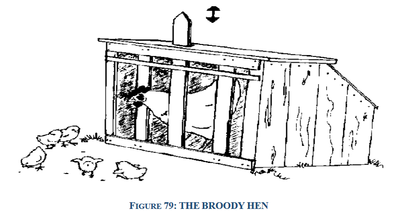
The broody hen is kept in a nesting box. Take her off the nest for 20 minutes each day to give her feed and drink. If a hen is used to incubate duck eggs you will need to sprinkle them with water for the last 14 days of the incubation period. The eggs of turkeys can also be incubated by a hen. A female turkey will lay up to 15 eggs but a brooding hen can only incubate up to 9 turkey eggs.
Care of brooding hens
To ensure that the brooding hen does not have any external parasites, she should be treated with a suitable dusting powder before being placed in the nesting box. The nesting material should also be lightly dusted with the powder. This will prevent any parasites being passed on to the chicks. Any holes in the box should be closed to prevent rats getting at the eggs and eating them.
White diarrhea disease kills large numbers of chickens. Do not hatch the eggs of birds which have been infected with this disease. The germ which causes the disease will be in the eggs and will infect the chicks. Ask your veterinary service about this disease in your area.
Production
Poultry enterprises may vary from basic backyard poultry keeping to mechanized and automated production plants. Various types of poultry enterprises are illustrated below.
|
|
Backyard poultry |
Farm flock |
Commercial poultry farm |
Specialized egg production |
Integrated egg production |
|
Subdivision of egg production |
Pullet growing, feed production |
Hatchery production separate from farming |
Feed production separate from poultry farms |
Chicken meat production becomes independent of egg production |
Separate enterprises reintegrated as a business |
|
Main management characteristics |
Natural hatching |
Artificial hatching and sexing |
Feed mixing |
Egg processing plant |
Controlled- environment houses |
|
Type of farming |
Subsistence farming |
Mixed farming |
Joint egg and meat production |
Eggs industry(single commodity) |
Egg complex |
|
Labour |
Part-time |
Part-time |
Full-time |
Division of management and labour |
Separate daily work and random work |
|
Building |
Free range |
Water feeder |
Water feeder |
Manure disposal equipment |
Egg belt automatically controlled house |
Backyard poultry : production is at the subsistence level of farming. Birds live free range and hatch their own eggs. Their diet is supplemented with crop waste or food leftovers. The labour involved in backyard poultry production is part-time.
Farm flock : production is slightly more specialized. Eggs are hatched at a separate location where the hatch and the sexing of the birds are controlled.
Commercial poultry : farm production involves full-time labour and is geared toward producing on a sufficient scale for the sale of both eggs and poultry meat.
Specialized egg production : consists of separating poultry for meat and egg production. In the egg producing plant, specialized employees oversee specific aspects of egg production.
Integrated egg production : is the most advanced enterprise and involves full mechanization and automation of the egg production cycle including battery egg laying, temperature controls, scientific feeding and mechanized egg collection methods.
Types of Brooders
Oil barrel - charcoal
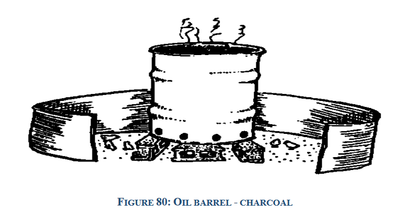
All of the above poultry-keeping methods are used in the developing world, but the majority of the enterprises are backyard poultry and farm flock production. The poultry and egg sectors are highly fragmented. Most of the production is carried out by a large number of farmers, each with a very small flock. The greater part of produce is sold in markets close to the farms.
Day-old chicks are usually obtained from local hatcheries licensed by international hybrid breeding companies. Farmers or cooperatives of farmers may choose between varieties of chickens for egg production and meat production.
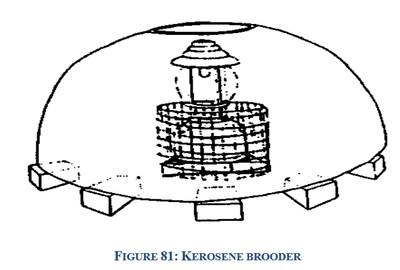
The small chicks can be either naturally or artificially brooded. If artificially brooded, small chicks must be placed in a separate house from laying chickens and it is necessary to protect the chicks from predators, diseases and catching colds. This stage of brooding lasts for eight weeks. In the first four weeks of life, small chicks need to be housed in a brooding box.
After the first month, small chicks are removed from the brooder box and placed in the brooder house. At two months of age, the chicks enter the grower stage which lasts until they are five months (20 weeks) old. Growers may either be housed separately from small chicks or continue to be reared in brooder-cum-grower houses. It is important to properly manage the growers as their reproductive organs develop during this period and this will affect their egg production capacity in the future.
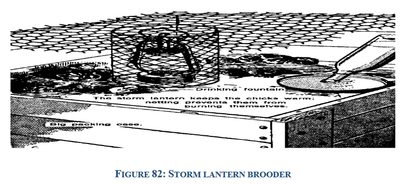
Types of laying houses
When the growers reach 18 weeks of age they are moved to laying houses and begin to lay eggs, which are, however, small and unmarketable. It is not until they are 21 weeks old that the growers reach their commercial laying stage. Layers may be placed in intensive, semi-intensive or free-range types of housing.
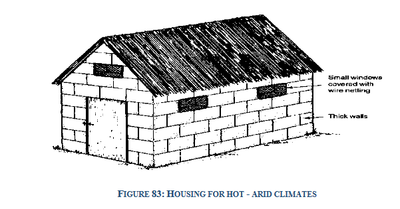
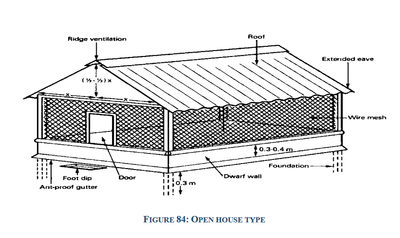
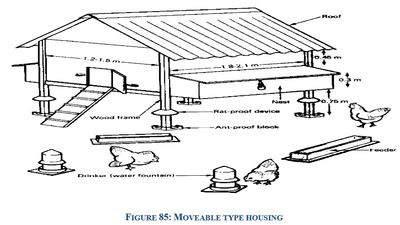
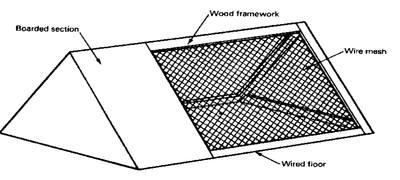
Factors affecting Egg Production
Typically, a layer’s production cycle lasts just over a year (52-56 weeks). During the production cycle many factors influence egg production; therefore, the cycle must be managed effectively and efficiently in order to provide maximum output and profitability. The following factors influence egg production.
Breed
The breed of the laying bird influences egg production. Management and feeding practices, however, are the key determining features for egg production.
Mortality rate
Mortality rate may rise due to disease, predation or high temperature. The mortality rate of small chicks (up to eight weeks of age) is about 4 percent; that of growers (between eight and 20 weeks of age) is about 15 percent; and that of layers (between 20 and 72 weeks of age) is about 12 percent. The average mortality rate of a flock is from 20 to 25 percent per year.
Age
Birds typically begin producing eggs in their twentieth or twenty-first week and continue for slightly over a year. This is the best laying period and eggs tend to increase in size until the end of the egg production cycle.
Body weight
In general, optimum body weight during the laying period should be around 1.5 kg, although this varies according to breed. Underweight as well as overweight birds lay eggs at a lower rate. Proper management and the correct amount of feed are necessary in order to achieve optimum body weight.
Laying house
The laying house should be built according to local climatic conditions and the farmer’s finances. A good house protects laying birds from theft, predation, direct sunlight, rain, excessive wind ,heat and cold, as well as sudden changes in temperature and excessive dust. If the climate is hot and humid, for example, the use of an open house construction will enable ventilation. The inside of the house should be arranged so that it requires minimum labour and time to care for the birds.
Lighting schedule
Egg production is stimulated by daylight; therefore, as the days grow longer production increases. In open houses, found commonly in the tropics, artificial lighting may be used to increase the laying period. When darkness falls artificial lighting can be introduced for two to three hours, which may increase egg production by 20 to 30 percent.
In closed houses, where layers are not exposed to natural light, the length of the artificial day should be increased either in one step, or in a number of steps until the artificial day reaches 16 to 17 hours, which will ensure constant and maximized egg production. Effective day length should never decrease during the laying period.
Feed
Free-range hens will produce more meat and eggs with supplemental feed, but only if they are improved breeds or crossbreeds. The selection of local hens is done on the basis of resistance and other criteria rather than feed utilisation for production.
Fresh and clean water should always be provided, as a layer can consume up to one-quarter of a litre a day.
Lighting schedule
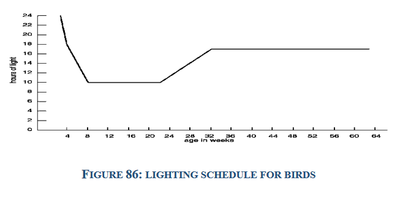
Culling
Culling is the removal of undesirable (sick and/or unproductive) birds, from the flock. There are two methods of culling:
- Mass culling, when the entire flock is removed and replaced at the end of the laying cycle; and
- Selective culling, when the farmer removes individual unproductive or sick birds.
Culling enables a high level of egg production to be maintained, prevents feed waste on unproductive birds and may avert the spreading of diseases.
Climate
The optimal laying temperature is between 11° and 26° C. A humidity level above 75 percent will cause a reduction in egg laying.
Temperature and its effects on egg production
|
Temperature (°C) |
Effects |
|
11 – 26 |
Good production. |
|
26 – 28 |
Some reduction in feed intake. |
|
28 – 32 |
Feed consumption reduced and water intake increased; eggs of reduced size and thin shell. |
|
32 – 35 |
Slight panting. |
|
25 – 40 |
Heat prostration sets in, measures to cool the house must be taken. |
|
40 and above |
Mortality due to heat stress. |
When the temperature rises above 28° C the production and quality of eggs decrease. Seasonal temperature increases can reduce egg production by about 10 percent.
Management factors
Effective and efficient management techniques are necessary to increase the productivity of the birds and consequently increase income. This entails not only proper housing and feeding, but also careful rearing and good treatment of the birds.
Vaccination and disease control
Diseases and parasites can cause losses in egg production. Some of the diseases are as follows:
- Bacterial: Tuberculosis, Fowl typhoid
- Viral: Newcastle, Fowl plague
- Fungal: Aspergillosis
- Protozoan: Coccidiosis
- Nutritional: Rickets, Perosis
Some of the parasites are:
- external: lice, mites
- internal: roundworms, tapeworms
Vaccinations are administered to birds by injection, water intake, eye drops and spraying. Clean and hygienic living quarters and surroundings may eliminate up to 90 percent of all disease occurrences.
Source : Pashu Sakhi Handbook
Last Modified : 5/15/2023
This topic provides information about the incubato...
This topic provides information about feeding chic...
This topic provides information about 20th Livesto...
This topic provides information about the problems...
